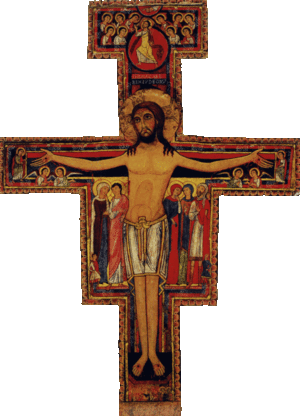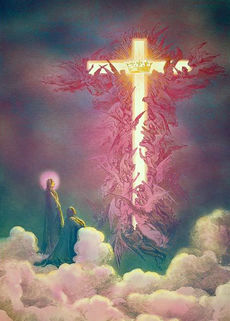Crucifixion: Difference between revisions
(added see also) |
m (link) |
||
| Line 37: | Line 37: | ||
In ''The Masters and the Path'', Charles Leadbeater describes the initiation of the crucifixion: | In ''The Masters and the Path'', Charles Leadbeater describes the initiation of the crucifixion: | ||
<blockquote>This Initiation differs from all the others in that it has this strange double aspect of suffering and victory. Each of the earlier [major] Initiations [on the spiritual path] was symbolized in the Christian system by one definite fact, the Birth, the Baptism, the Transfiguration; but in order to represent this fourth Initiation a series of events has been found necessary. The Crucifixion and all the varied sufferings of which it was the culmination were employed to typify one side of this Initiation, while the Resurrection with its triumph over death represents the other side. Always at this stage there is suffering, physical, astral and mental; always there is the condemnation by the world, and the apparent failure; always there is the splendid triumph upon higher planes—which, however, remains unknown to the outer world. The peculiar type of suffering which invariably accompanies this Initiation clears off any arrears of karma which may still stand in the Initiate’s way; and the patience and joyousness with which he endures them have great value in the strengthening of his character, and help to determine the extent of his usefulness in the work which lies before him.</blockquote> | <blockquote>This Initiation differs from all the others in that it has this strange double aspect of suffering and victory. Each of the earlier [major] Initiations [on the spiritual path] was symbolized in the Christian system by one definite fact, the Birth, the [[Baptism]], the Transfiguration; but in order to represent this fourth Initiation a series of events has been found necessary. The Crucifixion and all the varied sufferings of which it was the culmination were employed to typify one side of this Initiation, while the Resurrection with its triumph over death represents the other side. Always at this stage there is suffering, physical, astral and mental; always there is the condemnation by the world, and the apparent failure; always there is the splendid triumph upon higher planes—which, however, remains unknown to the outer world. The peculiar type of suffering which invariably accompanies this Initiation clears off any arrears of karma which may still stand in the Initiate’s way; and the patience and joyousness with which he endures them have great value in the strengthening of his character, and help to determine the extent of his usefulness in the work which lies before him.</blockquote> | ||
<blockquote>The Crucifixion and Resurrection which symbolize the actual Initiation are thus described in an ancient Egyptian formula: “Then shall the candidate be bound upon the wooden cross, he shall die, he shall be buried, and shall descend into the underworld; after the third day he shall be brought back from the dead.”</blockquote> | <blockquote>The Crucifixion and Resurrection which symbolize the actual Initiation are thus described in an ancient Egyptian formula: “Then shall the candidate be bound upon the wooden cross, he shall die, he shall be buried, and shall descend into the underworld; after the third day he shall be brought back from the dead.”</blockquote> | ||
Revision as of 17:22, 24 May 2021

The crucifixion of Jesus is the example of an initiation on the path of Christhood that all of the sons and daughters of God can take. Jesus set the example for this initiation, and he did not intend that he would be the only one who would ever pass through it. He made this clear when he said, as he was carrying his cross to Golgotha, “Daughters of Jerusalem, weep not for me, but weep for yourselves, and for your children.”[1]
The crucifixion of Jesus
The question that faced Jesus was not whether or not to be crucified, but it was whether or not to be crucified publicly. His agony in the Garden of Gethsemane, his being seized in the early morning hours, his trial before Pilate and Herod, represent the accusation, the trial, the judgment, that is leveled in every age against the son, the daughter of God who has the courage to elevate the Christ and to become the fullness of the Christ consciousness.
The crucifixion of Christ is for the judgment of all those who occupy the position of the authority of Christ and yet exercise it not as the Christ but as the Antichrist; and at the same time, the crucifixion is for the revelation that Christ is every man’s Real Self. And if the soul is to unite with that Real Self, that one must pass through this hour of the crucifixion.
Those who persecuted Jesus were the same ones whom he accused and to whom John the Baptist spoke with the great intensity of the fire of Almighty God, rebuking them and telling them to repent and to be baptized. Their intent was to kill the Christ, not the man, for they recognized his power to be the eternal Christ in him.
It is the Son of God in Jesus and in us all who experiences the crucifixion, and our souls experience this in the hour when, by the path of initiation, we are truly one in that Christ. The soul of Jesus, the Son of man, was one with that Christ; and therefore effectively, it was the integrated personality in God that was crucified.

The nature of the initiation
Part of the initiation of the crucifixion is bearing the momentum of planetary darkness. This is the darkness that Jesus had to bear which surrounded the cross while he was totally cut off from his Presence, relying solely on the memory of what it was like to feel his Presence and to be with God.
There comes a time when we all have to stand on our own light, what we have invoked. That is all we have and we are given no more. We have to go by that momentum until the hour of the dark night of the Spirit and the crucifixion has passed. And on the basis of the light we have gleaned, we see the unreality of death.
This initiation takes place for many people, after they pass on, at the etheric temple at Luxor in Egypt. It is also given in one of the chambers of the Great Pyramid, which is used at the etheric level for this test of laying down the body to see if man is attached to his body or if he knows that he is real in God. Just believing it is not enough. For in the hour of the dark night, all the momentums of the subconsciousness, which we call the electronic belt, rise up to challenge the light within man.
A false doctrine of sacrifice
Although the LORD had made known to Abraham that He did not require the sacrifice of his only son, although He had clearly spoken through his prophet Samuel, “Behold, to obey is better than sacrifice, and to hearken than the fat of rams,”[2] the influence of this ancient custom prevailed even to the time of Jesus. And the erroneous interpretation of the doctrine concerning the blood sacrifice of Jesus—which misconception he himself never taught—has been perpetuated to the present hour, a remnant of pagan rite long refuted by the Word of the LORD.
God the Father did not require the sacrifice of his son Christ Jesus, or of any other incarnation of the Christ, as an atonement for the sins of the world; nor is it possible according to cosmic law for any man’s sacrifice to balance either the original sin or the subsequent sins—the karma—of the one or the many. However, one man’s sacrifice of the lower self—resulting in the soul’s sublime reunion with the Christ—can set aside the return of individual and planetary karma for a prescribed period of grace wherein the mercy of the Law gives mankind an extended opportunity to make the selfsame sacrifice of the human consciousness for the Divine.
Only the right use of the power of the spoken Word, the Divine Logos, can atone for mankind’s sins. Only the Light of the Holy Spirit that flows through the Body of Christ (for which the Body and the Blood are symbols)[3] can transform the mortal into the immortal. Therefore, only the sacrifice of the misqualified energies of the electronic belt through the ritual of transmutation can redeem the Christ Light in man. Truly, man sacrifices his Christ-identity when he fails to offer the sacred Word to the Almighty “in remembrance of me.”[4] Truly, he is unredeemed until he partakes of the sacred fire Eucharist and invokes through his being the consecrated essence of the Father-Mother God.
Commands made in the name of the Ascended Sons and Daughters of God, then, are an acceptable sacrifice unto the living God. They replace the supposed need for either burnt offerings or animal or human sacrifice,[5] which for centuries both before and since the Christian dispensation have been placed on the altar of the Most High in the mistaken belief that these are required as a propitiation for the sins of the race.
Theosophical teaching
In The Masters and the Path, Charles Leadbeater describes the initiation of the crucifixion:
This Initiation differs from all the others in that it has this strange double aspect of suffering and victory. Each of the earlier [major] Initiations [on the spiritual path] was symbolized in the Christian system by one definite fact, the Birth, the Baptism, the Transfiguration; but in order to represent this fourth Initiation a series of events has been found necessary. The Crucifixion and all the varied sufferings of which it was the culmination were employed to typify one side of this Initiation, while the Resurrection with its triumph over death represents the other side. Always at this stage there is suffering, physical, astral and mental; always there is the condemnation by the world, and the apparent failure; always there is the splendid triumph upon higher planes—which, however, remains unknown to the outer world. The peculiar type of suffering which invariably accompanies this Initiation clears off any arrears of karma which may still stand in the Initiate’s way; and the patience and joyousness with which he endures them have great value in the strengthening of his character, and help to determine the extent of his usefulness in the work which lies before him.
The Crucifixion and Resurrection which symbolize the actual Initiation are thus described in an ancient Egyptian formula: “Then shall the candidate be bound upon the wooden cross, he shall die, he shall be buried, and shall descend into the underworld; after the third day he shall be brought back from the dead.”
Only after three clear days and nights and part of a fourth had passed was the still entranced candidate of those ancient days raised from the sarcophagus in which he had lain, and borne into the outer air at the eastern side of the pyramid or temple, so that the first rays of the rising sun might fall upon his face and awaken him from his long sleep.[6]
See also
For more information
Mark L. Prophet and Elizabeth Clare Prophet, The Path of the Universal Christ, pp. 167–88.
Mark L. Prophet and Elizabeth Clare Prophet, The Path to Immortality, pp. 241–46.
Sources
Mark L. Prophet and Elizabeth Clare Prophet, The Path of the Universal Christ, pp. 169, 170, 175.
Mark L. Prophet and Elizabeth Clare Prophet, The Path of the Higher Self, volume 1 of the Climb the Highest Mountain® series, chapter 6.
Pearls of Wisdom, vol. 53, no. 4.
